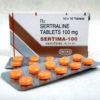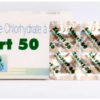Safety & Guarantee to United Kingdom, United States, Australia!
| Active substance | Sertaline (C17H17Cl2N) |
| US Brand | Tegretol |
| IN Brand | Sertima / Zosert / Zeden / Serta |
| Manufacturing by | Intas / Sun Pharma / Cadila / Unichem |
| Strength | 100mg |
| Form release | Blister 10 tab |
| Shipping time | 7 – 18 days (Depending from the Country) |
| Availability & Order | through request form |
Sertraline (trade names Zoloft and others) is an antidepressant of the selective serotonin reuptake inhibitor (SSRI) class. Sertraline is primarily prescribed for major depressive disorder in adult outpatients as well as obsessive-compulsive disorder, panic disorder, and social anxiety disorder, in both adults and children. In 2013, it was the most prescribed antidepressant and second most prescribed psychiatric medication (after alprazolam) on the U.S. retail market, with over 41 million prescriptions.
Differences with other newer antidepressants are subtle and mostly confined to side effects. It is similar in tolerability profile to other SSRIs, with the types of adverse events usually including diarrhea, nausea, and sexual dysfunction. The incidence of diarrhea was higher with sertraline—especially when prescribed at higher doses—in comparison to other SSRIs.
Sertraline is used for a number of conditions, including major depression, obsessive-compulsive disorder (OCD), body dysmorphic disorder (BDD), posttraumatic stress disorder (PTSD), premenstrual dysphoric disorder (PMDD), panic disorder and social anxiety disorder. It has also been used for premature ejaculation and vascular headaches but evidence of the effectiveness in treating those conditions is not robust.
Depression
A 2008 review concluded that 51% of studies of various SSRIs yielded positive outcomes. Sertraline is statistically similar in efficacy to other SSRIs such as paroxetine, citalopram, escitalopram and venlafaxine (SNRI). Evidence suggests that sertraline may be more effective than fluoxetine (Prozac) for some subtypes of depression.
Evidence does not show a benefit in children with depression.
With depression in dementia, there is no benefit compared to either placebo or mirtazapine.
Other anxiety disorders
Sertraline is effective for the treatment of social phobia. Improvement in scores on the Liebowitz Social Anxiety Scale were found with sertraline but not with placebo. A combination of sertraline and cognitive behavioural therapy has a superior response rate when used in children.
There is tentative evidence that sertraline, as well as other antidepressants, can help with the symptoms of general anxiety disorder.[41] The trials have generally been short in length and the medicals are associated with side effects.
Usual Adult Dose for Depression
Initial dose: 50 mg orally once a day
Maintenance Dose: 50 to 200 mg orally once a day
Comments:
-Dose adjustments may be made at intervals of at least one week.
-Obsessive Compulsive Disorder and acute episodes of Major Depressive Disorder require several months or longer of sustained pharmacologic therapy.
Usual Adult Dose for Obsessive Compulsive Disorder
Initial dose: 50 mg orally once a day
Maintenance Dose: 50 to 200 mg orally once a day
Comments:
-Dose adjustments may be made at intervals of at least one week.
-Obsessive Compulsive Disorder and acute episodes of Major Depressive Disorder require several months or longer of sustained pharmacologic therapy.
Usual Adult Dose for Panic Disorder
Initial dose: 25 mg orally once a day, increased after one week to 50 mg orally once a day
Maintenance dose: 50 to 200 mg orally once a day
Comments:
-Dose adjustments may be made at intervals of at least one week.
-These conditions generally required several months or longer of sustained pharmacological therapy beyond initial treatment.
Usual Adult Dose for Post Traumatic Stress Disorder
Initial dose: 25 mg orally once a day, increased after one week to 50 mg orally once a day
Maintenance dose: 50 to 200 mg orally once a day
Comments:
-Dose adjustments may be made at intervals of at least one week.
-These conditions generally required several months or longer of sustained pharmacological therapy beyond initial treatment.
Usual Adult Dose for Social Anxiety Disorder
Initial dose: 25 mg orally once a day, increased after one week to 50 mg orally once a day
Maintenance dose: 50 to 200 mg orally once a day
Comments:
-Dose adjustments may be made at intervals of at least one week.
-These conditions generally required several months or longer of sustained pharmacological therapy beyond initial treatment.
Usual Adult Dose for Premenstrual Dysphoric Disorder
Continuous regimen:
Initial dose: 50 mg orally once a day during the menstrual cycle
Maintenance dose: 50 to 150 mg orally once a day during the menstrual cycle
Cyclic regimen:
Initial dose: 50 mg orally once a day starting 14 days prior to the anticipated start of menstruation through to the first full day of menses, and repeated with each new cycle
Maintenance dose: 50 to 100 mg orally once a day
Comments:
-The dose may be increased in increments of 50 mg per menstrual cycle, increased at the onset of each new cycle; dosage adjustments may also include changes between regimens.
-If a 100 mg once daily dose has been established with the cyclic regimen, a titration step of 50 mg per day for three days should be used at the beginning of each dosing period (luteal phase of the menstrual cycle).
-The effectiveness of sertraline for longer than three months has not been systematically evaluated in controlled trials.
Usual Pediatric Dose for Obsessive Compulsive Disorder
6 to 12 years:
Initial dose: 25 mg orally once a day
Maintenance dose: 25 to 200 mg orally once a day
13 to 17 years:
Initial dose: 50 mg orally once a day
Maintenance dose: 50 to 200 mg orally once a day
Comments:
-The dose may be increased at intervals of at least one week.
-The potential risks versus clinical need should be assessed prior to using this drug in children and adolescents.
Compared to other SSRIs, sertraline tends to be associated with a higher rate of psychiatric side effects and diarrhea. It tends to be more activating (that is, associated with a higher rate of anxiety, agitation, insomnia, etc.) than other SSRIs, aside from fluoxetine.

